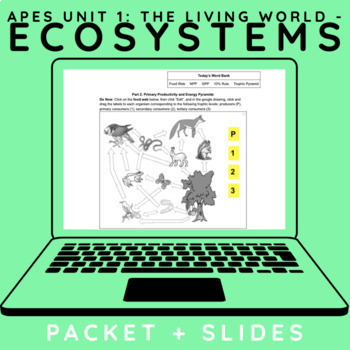AP Environmental Science - Unit 1: The Living World - Ecosystems PACKET & SLIDES
- Google Drive™ folder

What educators are saying
Also included in
- This purchase includes 9 unit plans, including a unit packet for students and complete, ready-to-use slideshow for each unit in the CED for AP Environmental Science (APES). NOW UPDATED TO INCLUDE a unit planning guide/overview for every unit as well! This bundle was designed for distance learning, bPrice $139.99Original Price $179.91Save $39.92
Description
This purchase is a 5-day unit plan for the first unit in the CED for AP Environmental Science (APES): Unit 1: The Living World - Ecosystems. Provided with your purchase is a unit packet for students, a ready-to-use teacher slideshow, a planning guide/overview of the unit for teachers, and an answer key for teacher use. Great for distance learning or for use in the classroom!
The unit breakdown is as follows:
Part 1: Ecosystem Structure and Flow of Energy
Part 2: Primary Productivity and Energy Pyramids
Part 3: Species Interactions
Part 4: Biogeochemical Cycles
Part 5: Terrestrial and Aquatic Biomes
This unit plan includes activities and skills such as free response writing, matching, reading, graphic organizers, guided notes, and model building to improve understanding. The unit packet comes with a word bank, Do Now, objective, and distinct activities for each of the 5 parts listed above. The teacher slides are ready to use, either live during a Zoom or in-person meeting or to be posted for students to access asynchronously. Both the student-facing unit packet and slideshow are hosted by Google (Google Docs and Google Slides). Ready to teach!
All topics listed in the new CED for this unit are covered in this unit plan.
For more AP Environmental Science Resources, view the complete list of EnvironmentLA APES products here.
Check out all of our complete APES units, designed for distance/digital learning:
Unit 1: The Living World - Ecosystems Complete Unit (Packet + Slides)
Unit 2: The Living World - Biodiversity Complete Unit (Packet + Slides)
Unit 3: Populations (Packet + Slides)
Unit 4: Earth Systems and Resources (Packet + Slides)
Unit 5: Land and Water Use (Packet + Slides)
Unit 6: Energy Resources and Consumption (Packet + Slides)
Unit 7: Atmospheric Pollution (Packet + Slides)
Unit 8: Aquatic & Terrestrial Pollution (Packet + Slides)
Unit 9: Global Change (Packet + Slides)
***NEW: FULL YEAR APES CURRICULUM BUNDLE FROM ENVIRONMENTLA!***
If you're enjoying your unit from EnvironmentLA, teach our resources all year long with this brand-new bundle, including all 9 units, each with distinct unit packets and slides that are easy to use and ready to teach!
--> Shop the bundle HERE! <--






